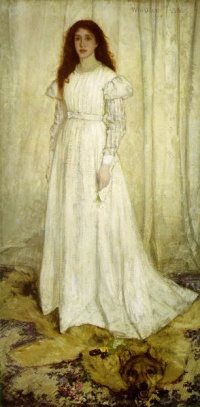1862
From The Art and Popular Culture Encyclopedia
(Difference between revisions)
| Revision as of 09:16, 1 May 2021 Jahsonic (Talk | contribs) ← Previous diff |
Revision as of 12:45, 5 May 2021 Jahsonic (Talk | contribs) Next diff → |
||
| Line 15: | Line 15: | ||
| *[[Karl Ulrichs]], speaking at a conference of Jurists in Munich, becomes the first person in modern times to declare himself homosexual. Although he used the term, "[[Urning]]," Ulrichs continued to speak out for gay rights. | *[[Karl Ulrichs]], speaking at a conference of Jurists in Munich, becomes the first person in modern times to declare himself homosexual. Although he used the term, "[[Urning]]," Ulrichs continued to speak out for gay rights. | ||
| *[[Elizabeth Siddall]] died of an overdose | *[[Elizabeth Siddall]] died of an overdose | ||
| + | *"[[Protestation des grands artistes contre toute assimilation de la photographie à l'art]]", a manifesto by Ingres, signed by 26 | ||
| ===Literature=== | ===Literature=== | ||
| *''[[Salammbô]]'' by Gustave Flaubert | *''[[Salammbô]]'' by Gustave Flaubert | ||
Revision as of 12:45, 5 May 2021
|
"Satanism and Witchcraft (1862) is a book on the history of witchcraft by Jules Michelet. According to Michelet, medieval witchcraft was an act of popular rebellion against the oppression of feudalism and the Roman Catholic Church. This rebellion took the form of a secret religion inspired by paganism and fairy beliefs, organized by a woman who became its leader. The participants in the secret religion met regularly at the witches' sabbath and the Black Mass. Michelet's account is openly sympathetic to the sufferings of peasants and women in the Middle Ages."--Sholem Stein |
Image:The Birth of Venus (Duval).jpg
The Birth of Venus(La Naissance de Vénus) (1862) by Amaury Duval

James Whistler's painting Symphony in White, No. 1: The White Girl (1862) caused controversy when exhibited in London and, later, at the Salon des Refusés in Paris. The painting epitomizes his theory that art should essentially be concerned with the beautiful arrangement of colors in harmony, not with the accurate portrayal of the natural world.
|
Related e |
|
Featured: |
1862 is a year of the 1860s.
Contents |
Art and culture
- Fyodor Dostoevsky visits the Crystal Palace
- Swinburne meets Richard Monckton Milnes, who introduced him to Richard Burton and to the works of the Marquis de Sade.
- Bohemianism quote: "The term 'Bohemian' has come to be very commonly accepted in our day as the description of a certain kind of literary gipsey, no matter in what language he speaks, or what city he inhabits .... A Bohemian is simply an artist or littérateur who, consciously or unconsciously, secedes from conventionality in life and in art." ["Westminster Review"]
- Karl Ulrichs, speaking at a conference of Jurists in Munich, becomes the first person in modern times to declare himself homosexual. Although he used the term, "Urning," Ulrichs continued to speak out for gay rights.
- Elizabeth Siddall died of an overdose
- "Protestation des grands artistes contre toute assimilation de la photographie à l'art", a manifesto by Ingres, signed by 26
Literature
- Salammbô by Gustave Flaubert
- 20 poems from the future Spleen de Paris collection by Charles Baudelaire are published
- Les Misérables by Victor Hugo
- Lady Audley's Secret by Mary Elizabeth Braddon
- La sorcière by Jules Michelet
Art
- Symphony in White, No. 1: The White Girl by Whistler
- The Turkish Bath by Jean Auguste Dominique Ingres
- La Source by Gustave Courbet
- The Cedars of Lebanon by Edward Lear
- The Birth of Venus by Duval
Technology
- Ponti's Megalethoscope
Births
- Gustav Klimt (1862 - 1918)
- Claude Debussy (1862 - 1918)
- Rupert Carabin (1862 - 1952)
- Arthur Schnitzler (1862 - 1931)
- Maurice Barrès (1862 - 1923)
- Joseph Carey Merrick (August 5, 1862 - April 11, 1890), known as "The Elephant Man",
Deaths
- Henry David Thoreau (1817-1862)
Unless indicated otherwise, the text in this article is either based on Wikipedia article "1862" or another language Wikipedia page thereof used under the terms of the GNU Free Documentation License; or on research by Jahsonic and friends. See Art and Popular Culture's copyright notice.

